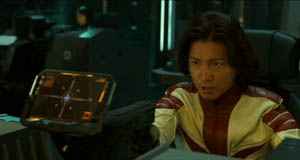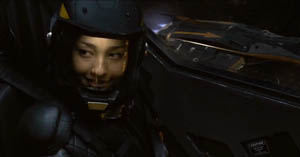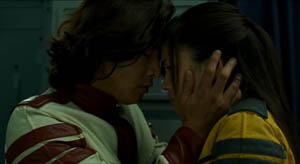|
 This is how it is: In the year 2199, Earth was under severe attack from the mysterious planet Gamilas. Gamilas bombs have covered Earth with radioactive pollution, and, as a result, in one year's time, Earth will be unlivable. This I heard, give or take a word here and there, like a daily mantra for much of my youth. So ran the prologue of the syndicated animated SF drama Star Blazers, which arrived on US airwaves in 1979 and drastically redefined the potential not only of animated programming, but of television programming in general with its epic storytelling and powerful character drama. Those who paid close attention learned, via the closing credits, that the series originated in Japan under the title of Space Cruiser Yamato (a slightly errant translation later corrected to Space Battleship Yamato). Yamato had been an ambitious undertaking and early ratings failure that got a new lease on life in the post-Star Wars craze for space adventure, eventually spawning two sequel series, a TV feature, and five animated theatrical films to date. Virtually a national treasure in Japan, it finally culminated in this, the most expensive Japanese feature film ever, released to huge returns thirty-six years after the original animated series was shortened from thirty-nine to twenty-six episodes due to low ratings. 
The underlying story remains the same: Earth is nearly uninhabitable due to radioactive bombs, and Earth's space fleet proves no match for the Gamilas warships. Mamoru Kodai bravely throws his own ship into harm's way to allow fleet commander Captain Jyuzo Okita's ship to escape and return to Earth, despite Okita's pleas to the contrary. Mamoru's younger brother, Susumu Kodai, sees things differently-Okita sacrificed Mamoru to save himself. Okita makes no attempts at self-absolution, taking the brunt of the guilt. Bitter experience has taught him to simply bear the pain and soldier on. At the same time, a ray of hope appears in the form of a communique from deep in space, providing engine schematics and distant coordinates, along with a tantalizing possibility: that the radiation that will soon lead to humankind's extiction can be eliminated, and humans could conceivably leave their underground shelters and reclaim the surface of their homeworld. Okita proposes a radical mission-to take the ancient WWII battleship Yamato, retrofitted with the alien technology into an evacuation vessel, and instead seek out the impossibly distant planet of Iscandar, source of the message and possibly Earth's salvation. 
The tale is an old one, the classic quest for the boon. (With an eye towards the story's mythological underpinnings, the Star Blazers adaptation had aptly renamed the ship Argo, after the story of Jason and the Golden Fleece.) Young Susumu Kodai has joined the mission in part to try to discover just what sort of man Captain Okita really is. Where Okita is resolute and unflinching, Kodai is passionate and idealistic. He reacts to his own unexpected ability to make a hard command decision as evidence of his unsuitability for command. Beneath the captain's stoicism, we see something else. Taciturn and gruff, he periodically shares a drink of water with a small plant he keeps by his bedside, a living, growing memento of the home he wishes to see restored. The pair chafe at one another, two men both bereft of living family, almost unwilling to believe they are cut from the same cloth, still needing one another. Yet Okita is ultimately the greatest idealist of all, staking everything on the most desperate hope. The Star Blazers script had the kindly old chief engineer advising the brash young hero of his captain's worth thus: "He's a fine leader. He knows what must be done, and even if he has to pay a price he does it, and he doesn't blame others. He just goes on. Could you do the same?" While the line doesn't occur verbatim in the movie, the sentiment remains. The overtly Cambellian nature of the plot is such that it may have some western viewers crying foul, citing comparisons with Star Wars, unaware of the story's 1974 origins. 
It's clear that the filmmakers had a great love for the source material, as the film is largely a confabulation of the first two Yamato stories, with many memorable moments recreated, often including image composition and dialogue. At the same time, as with any adaptation of a long work into a shorter one, there was the necessity of making a film with a logical and smooth internal flow, one not requiring familiarity with a decades-old animated series that much of the international audience would not know. Some of these were minor: most of the characters are somewhat older here. Kodai has less growing up to do, because he has less time in which to do it. Others are more over-arching. The story is now told strictly from one side. The animated series and movies featured prominent adversarial characters, and there were a great many recurring Gamilas, epitomized by the enigmatic Desslar, one of the more richly-drawn villains to be found in dramas of this sort. In the movie, he's relagated to a background presence, and the Gamilas race is now more alien in nature, as opposed to the blue-skinned humanoids previously featured. The change may rankle some, but consider practical application of the alternative. Would blue-painted actors really fly as aliens in a live-action movie? Would they, like the human characters, be played entirely by Japanese actors? The thought seems frankly ridiculous. Might they instead be played by white actors in blue makeup? It seems no less ridiculous, and also slightly uncomfortable on top of that, rather like the '60s Star Trek's swarthy-skinned Klingons, who now look disquietingly racist in conception. The change in the nature of the aliens also allows for a cleverly-executed workaround for the logically absurd conceit that extraterrestrials would speak flawlessly in Earthly languages. 
The special effects are in general excellent and dynamic, if not quite state-of-the-art by domestic standards. Nevertheless, I find complaining about CGI in the current day to be verging on ridiculous, tantamount to asserting that the 1974 series' low frame rate, sometimes miscolored cels, and occasional animation glitches devalued the quality of the story being told. Of course, some probably have voiced such complaints, as nitpicking and complaining about anything one can find fault with seems to comprise the bulk of many people's recreational activities. One could conceivably cite any number of personal issues. It's true that space in the original felt more romanticized, filled with swirling storms and brightly-colored stars. Here, space more accurately lives up to its name. The ship itself somehow seems not to loom quite so large; as the biggest battleship ever built, the Yamato should never feel anything other than immense in scale. And really, Steven Tyler? They couldn't have managed to get Isao Sasaki to record a new version of the classic Scarlet Scarf closing theme instead (after all, he did return as narrator)? But all of these complaints bob and weave around the matters of primary import, which are story and character. Those, thankfully, remain to remind us that action-adventure movies need not be sundered from any sense of purpose and meaning. -review by Matt Murray
|
|
||||||||